初中英语教师资格证面试试讲真题(截图版)
教师资格证初中英语面试真题集

1.试讲题目:阅读教学试讲2.内容:Class 9 had a great time on the school trip. They went to Blue Water Aquarium for the day. First they visited the visitors center and watched about sharks. Then they watched a dolphin show. After that, they went to the outdoor Pool and saw a big octopus. After lunch, they went to the Gift Shop and bought lots of gifts. Finally, tired but happy, they took the bus back to school. At the end of the day, the science teacher was very happy because the class monitor cleaned the bus after the trip.3. 基本要求:(1)朗读所给段落。
(2)配合教学内容适当的板书。
(3)针对该段落中的划线部分,设计相应的阅读后教学活动。
(4)试讲时间:约10分钟。
(5)用英文试讲。
1.写作教学试讲2.内容:Dear Editor,I am writing to say that I am against building a new zoo in our town. Zoos are terrible places for animals to live. I’ve visited a lot of zoos in my life, and I have never seen one I liked or one that was suitable for animals to live in. Just last week, I visited a zoo and couldn’t believe what I saw. The animals are keptin tiny cages and can hardly move at all. And they are only given food once a day. Is this a good way for animals to live? I don’t think so.Sincerely,Disgusted 3 基本要求:(1)朗读所给短信。
(历年真题)下半年中学英语教师资格证面试试讲真题【网友版】

下半年中学英语教师资格证面试试讲真题【网友版】
高中英语真题:
1•同位语从句
2. Morni ngt on Tow n ,设计成写作课
3. 试讲:阅读课,Crouching Tiger, Hidden Dragon注意-下fiance 的读音
4•阅读特洛伊战争注意人名和特洛伊的读法
词汇课:takeupgettobeflledwith
5•口语对话robbie和susan讨论世界上有没有外星人,一个相信,一个不相信, 朗读课文,教学生怎么根据语调表达情感和态度
6.试讲听说课描述方向turn left turn right(答辩是teachi ng in te ntion和怎么知道每个学生都学会了这个知识点
初中英语真题:
1•语法题used to do的用法
2•阅读题,不同的国家学生去上学的方式
3. North America nJape n
4•语音题讲the th ink的发音s的s发音以及because的s发音
5.阅读课mobile phone
6. 口语课,what about
7•写作,一个图片画着男生坐那里,身边有很多篮球足球。
文章是说他有很多球,但他从来不玩,只看电视。
8.口语课是一篇关于coach和nek之间的对话,问nick的名字电话电子邮件
超等等。
9•语音音标
10、区分th,s,se的发音。
2022年教师资格证面试真题:初中英语试讲
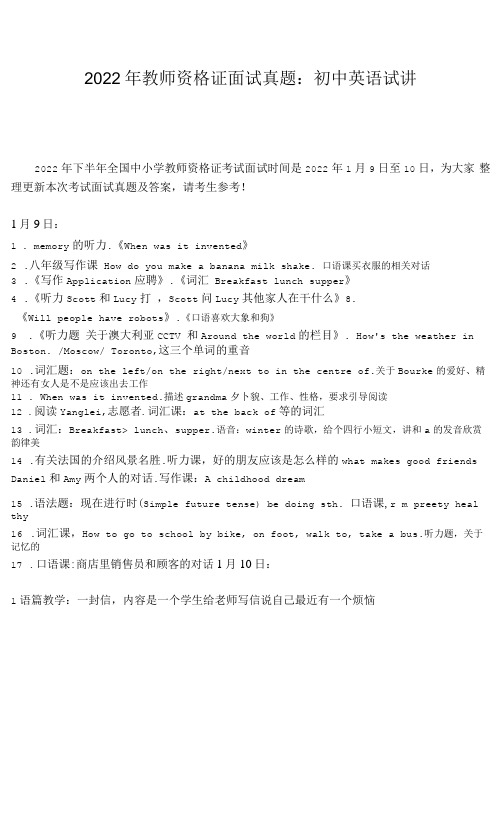
2022年教师资格证面试真题:初中英语试讲2022年下半年全国中小学教师资格证考试面试时间是2022年1月9日至10日,为大家整理更新本次考试面试真题及答案,请考生参考!1月9日:1. memory的听力.《When was it invented》2.八年级写作课How do you make a banana milk shake. 口语课买衣服的相关对话3.《写作Application应聘》.《词汇Breakfast lunch supper》4.《听力Scott和Lucy打,Scott问Lucy其他家人在干什么》8.《Will people have robots》.《口语喜欢大象和狗》9.《听力题关于澳大利亚CCTV 和Around the world的栏目》. How's the weather in Boston. /Moscow/ Toronto,这三个单词的重音10.词汇题:on the left/on the right/next to in the centre of.关于Bourke的爱好、精神还有女人是不是应该出去工作11. When was it invented.描述grandma夕卜貌、工作、性格,要求引导阅读12.阅读Yanglei,志愿者.词汇课:at the back of等的词汇13.词汇:Breakfast> lunch、supper.语音:winter的诗歌,给个四行小短文,讲和a的发音欣赏韵律美14.有关法国的介绍风景名胜.听力课,好的朋友应该是怎么样的what makes good friends Daniel和Amy两个人的对话.写作课:A childhood dream15.语法题:现在进行时(Simple future tense) be doing sth. 口语课,r m preety heal thy16.词汇课,How to go to school by bike, on foot, walk to, take a bus.听力题,关于记忆的17.口语课:商店里销售员和顾客的对话1月10日:1语篇教学:一封信,内容是一个学生给老师写信说自己最近有一个烦恼。
教师资格考试初中面试英语试题与参考答案
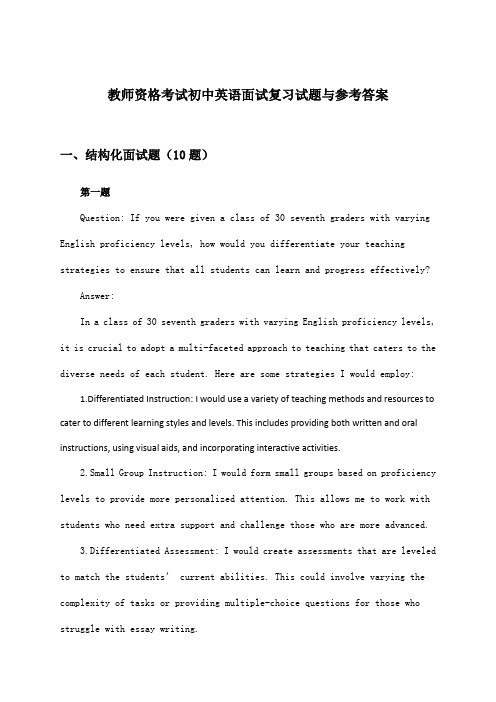
教师资格考试初中英语面试复习试题与参考答案一、结构化面试题(10题)第一题Question: If you were given a class of 30 seventh graders with varying English proficiency levels, how would you differentiate your teaching strategies to ensure that all students can learn and progress effectively?Answer:In a class of 30 seventh graders with varying English proficiency levels, it is crucial to adopt a multi-faceted approach to teaching that caters to the diverse needs of each student. Here are some strategies I would employ:1.Differentiated Instruction: I would use a variety of teaching methods and resources to cater to different learning styles and levels. This includes providing both written and oral instructions, using visual aids, and incorporating interactive activities.2.Small Group Instruction: I would form small groups based on proficiency levels to provide more personalized attention. This allows me to work with students who need extra support and challenge those who are more advanced.3.Differentiated Assessment: I would create assessments that are leveled to match the students’ current abilities. This could involve varying the complexity of tasks or providing multiple-choice questions for those who struggle with essay writing.nguage Support: For students who are still developing their English language skills, I would incorporate language support strategies such as using simplified language, providing glossaries, and using gestures and body language to aid comprehension.5.Encouragement and Motivation: I would make sure to praise and encourage all students, recognizing their efforts and progress. Motivation is key to keeping all students engaged and committed to learning.6.Differentiated Homework: I would assign homework that is appropriate for each student’s level, ensuring that it i s neither too easy nor too difficult. This could involve extension activities for more advanced students and review exercises for those who need extra practice.Explanation:Differentiated instruction is essential in a classroom with diverse learners. By implementing a variety of strategies, I aim to provide an inclusive learning environment where each student feels valued and supported. The focus is on meeting students where they are and helping them to reach their full potential in English language learning.第二题Question:How would you effectively differentiate instruction in your middle school English classroom to cater to the diverse learning styles, abilities, and backgrounds of your students?Answer:In my middle school English classroom, I would employ a variety of strategies to differentiate instruction that accommodate different learning styles, abilities, and backgrounds. Here’s how I would approach this:1.Assessment for Learning: Before planning lessons, I would conduct formative assessments to understand each student’s strengths, weaknesses, and preferred learning modalities. This could include reading comprehension quizzes, writing samples, or speaking and listening exercises.2.Flexible Grouping: I would use flexible grouping techniques, such as mixed-ability or interest-based groups, to create an inclusive learning environment. This allows students to work together, collaborate, and learn from one another.3.Adaptive Instruction: For students with varying abilities, I would provide modified assignments and support. For example, I could offer simpler versions of reading materials for struggling readers or more challenging texts for advanced learners.4.Visual and Auditory Aids: To cater to visual and auditory learners, I would incorporate multimedia resources, such as videos, interactive presentations, and audio recordings, into my lessons.5.Hands-On Activities: For kinesthetic learners, I would incorporate hands-on activities, such as role-playing, group projects, and interactive games, to engage their physical movement and reinforce learning.6.Cultural Responsiveness: Recognizing the diverse backgrounds of mystudents, I would incorporate culturally relevant materials and themes into my teaching. This includes using literature that reflects the experiences and perspectives of various cultures.7.Differentiated Homework: I would assign differentiated homework that allows students to demonstrate their understanding in various ways. Some students might complete a written assignment, while others might create a presentation, a podcast, or a visual representation of the lesson.8.Feedback and Support: I would provide timely and specific feedback to each student, highlighting their strengths and suggesting areas for improvement. Additionally, I would offer support through tutoring sessions or one-on-one conferences.Explanation:Differentiation in the classroom is crucial because it ensures that all students have the opportunity to learn and succeed. By using a combination of these strategies, I can create a dynamic and responsive learning environment that addresses the unique needs of each student. This approach not only enhances student engagement but also fosters a sense of belonging and inclusivity within the classroom.第三题Question: As an English teacher for junior high school, how would you differentiate your teaching methods for students with different learning styles (e.g., auditory, visual, kinesthetic)?Answer:In response to the diverse learning styles of students, I would implement a multifaceted teaching approach that caters to auditory, visual, and kinesthetic learners. Here’s a breakdown of my strategies for each type of learner:1.Auditory Learners:•Incorporate songs, rhymes, and chants into the lessons to reinforce vocabulary and grammar.•Use storytelling techniques to engage students in the narrative, thereby enhancing their listening skills.•Facilitate discussions and group activities that encourage speaking and listening, such as debates or role-playing exercises.2.Visual Learners:•Create visual aids like flashcards, diagrams, and posters to illustrate concepts and vocabulary.•Utilize multimedia resources, such as videos and slideshows, to present information in a visually engaging manner.•Design interactive whiteboards or use projectors to display key points during lessons, allowing students to follow along visually.3.Kinesthetic Learners:•Introduce activities that require physical movement, like “Simon Says”games for vocabulary practice or “Simon Says” for gr ammar exercises.•Encourage students to engage in hands-on projects, such as creating theirown booklets or posters to showcase their understanding of the lesson material.•Use role-playing and simulations to provide kinesthetic learners with a concrete context in which to apply their language skills.By incorporating these diverse teaching methods, I aim to provide a comprehensive learning experience that caters to the varying needs of my students. Additionally, I would continually assess their progress and adjust my strategies as needed to ensure that each student has the opportunity to succeed.Explanation:The answer provided above outlines a comprehensive approach to catering to the different learning styles of students in a junior high school English classroom. It emphasizes the importance of incorporating a variety of teaching methods to engage students with different learning preferences. By addressing auditory, visual, and kinesthetic learners, the teacher demonstrates a commitment to creating an inclusive and supportive learning environment. The explanation provides a rationale for each teaching strategy, highlighting the benefits of using these methods for each type of learner.第四题Question: How would you handle a situation where a student in your class has a strong negative attitude towards learning English, and this attitude is affecting their performance and the class dynamic?Answer:1.Initial Assessment: First, I would observe the student’s behavior and interactionswithin the classroom to understand the root cause of their negative attitude. It’s essential to gather information from various sources such as the student, their peers, and their parents.2.One-on-One Conversation: I would initiate a private conversation with the student to express concern for their well-being and to discuss their feelings about learning English. This allows the student to feel valued and understood.3.Encourage Openness and Empathy: During the conversation, I would encourage the student to share their thoughts and feelings without fear of judgment. I would listen actively and show empathy to build a rapport.4.Identify Challenges: We would identify the specific challenges the student is facing, whether they are related to the curriculum, learning style, peer pressure, or personal issues.5.Tailor Instruction: Based on the identified challenges, I would adapt my teaching methods to better suit the student’s needs. This could include using different resources, adjusting the pace of learning, or incorporating student interests into lesson plans.6.Peer Support: I would encourage positive peer interaction by forming study groups or peer tutoring sessions where students can support each other.7.Positive Reinforcement: I would use positive reinforcement techniques to acknowledge the student’s effort s and progress, regardless of the outcomes, to build their confidence.8.Collaborate with Parents and Guardians: I would involve the student’s parents or guardians in the process to provide additional support and to ensure consistency between home and school.9.Regular Check-ins: I would schedule regular check-ins with the student to monitor their progress and adjust strategies as necessary.10.Professional Development: If the issue persists, I would seek guidance from colleagues, mentors, or professional development resources to refine my approach.Explanation:The key to handling such a situation is to approach it with patience, understanding, and a commitment to the student’s growth. By understanding the underlying reasons for the negative attitude, tailoring the learning experience, and fostering a supportive environment, it is possible to turn around a student’s attitude and improve their performance and the class dynamic. It’s also important to maintain open communication channels with all stakeholders to ensure a holistic approach to the student’s education.第五题Question:As an English teacher for junior high school students, how would you differentiate your teaching methods to cater to students with diverse learning styles, such as visual, auditory, and kinesthetic learners?Answer:As an English teacher aiming to cater to students with diverse learning styles, I would adopt a multifaceted approach that integrates various teaching methods to engage all types of learners. Here’s how I would differentiate myteaching for visual, auditory, and kinesthetic learners:1.Visual Learners:•Use visual aids such as flashcards, posters, and diagrams to illustrate vocabulary and grammar points.•Create presentations and videos that include visual examples of language use in real-world contexts.•Encourage students to create their own visual summaries of texts or stories they have read.2.Auditory Learners:•Incorporate songs, poems, and dialogues into lessons to reinforce language learning through listening.•Conduct discussions and group activities where students can engage in verbal interactions.•Use storytelling and role-plays to help auditory learners absorb and remember the language.3.Kinesthetic Learners:•Design activities that involve physical movement, such as “Simon Says”games or theater exercises to practice language.•Incorporate hands-on activities like making models or dioramas to represent stories or concepts.•Encourage kinesthetic learners to act out scenes or use puppets to express their understanding of the material.Explanation:Differentiating instruction is essential to ensure that all students have the opportunity to learn effectively. By recognizing and addressing the specific needs of visual, auditory, and kinesthetic learners, I can create a classroom environment that caters to their preferences and strengths. This approach not only helps to engage all students but also enhances their overall language acquisition and retention. Additionally, it fosters a more inclusive classroom where students feel valued and understood, leading to higher levels of motivation and success.第六题Question:If you were teaching a group of初中 students who were struggling with understanding the past perfect tense, how would you adapt your teaching methods to ensure they grasp the concept effectively?Answer:1.Assess Understanding: Begin by assessing the students’ current understanding of the past perfect tense through a brief quiz or discussion. This will help identify their specific areas of confusion.e Real-Life Examples: Present real-life examples that naturally incorporate the past perfect tense. For instance, you could discuss a historical event and use sentences like, “The Great Wall had been built for centuries before the tourists arrived.”3.Visual Aids: Create visual aids such as timelines or storyboards to illustrate the sequence of events that require the use of the past perfect tense.This can help students visualize the concept.4.Interactive Activities: Engage students in interactive activities such as role-playing, where they can practice using the past perfect tense in context. For example, students could act out a scenario where one person asks about another’s past experiences.5.Collaborative Learning: Pair students up or form small groups to discuss and create sentences using the past perfect tense. This encourages peer learning and can help clarify misunderstandings.6.Consistent Practice: Incorporate regular practice sessions into your lessons, where students can practice forming and using past perfect tense sentences. This could include completing worksheets, online exercises, or oral drills.7.Differentiated Instruction: Recognize that students have different learning styles. Offer alternative methods such as video tutorials, audio recordings, or written explanations for those who may need additional support.8.Feedback and Adjustment: Provide immediate feedback on students’ usage of the past perfect tense and be prepared to adjust your teaching methods based on their progress and feedback.Explanation:The key to teaching the past perfect tense effectively to struggling students lies in making the concept relatable and accessible. By using real-life examples, visual aids, and interactive activities, students can engage with the materialin a way that resonates with them. Additionally, by offering a variety of teaching methods and allowing for collaborative learning, students can learn from each other and reinforce their understanding. Regular practice and personalized feedback ensure that each student receives the support they need to master the concept.第七题Question:Discuss the importance of integrating technology in teaching English to junior high school students and provide an example of how you would use technology in your classroom.Answer:Integrating technology into the teaching of English to junior high school students is essential for several reasons. Firstly, it enhances student engagement by providing interactive and dynamic learning experiences that can cater to different learning styles. Secondly, technology facilitates access to a vast array of resources, such as authentic materials from English-speaking countries, which can improve students’ language skills and cultural understanding. Additionally, using technology can help prepare students for a digital world where online communication and digital literacy are increasingly important.For example, I could incorporate a video project into my lesson plan where students work in groups to create short films or presentations on topics relatedto the curriculum. They would be required to research their topic, write scripts, record videos, and edit them using software like iMovie or Windows Movie Maker. This activity not only promotes collaborative learning and creativity but also provides practical experience with digital tools that are relevant to today’s job market. Furthermore, by sharing these projects with the class, students can practice their speaking and listening skills while receiving constructive feedback from their peers and teacher.Explanation:This question assesses the candidate’s ability to recognize the benefits of using technology in education and apply this knowledge practically. The answer provided demonstrates an understanding of how technology can enhance the learning environment and support the development of 21st-century skills. By giving a specific example of a video project, the response shows that the teacher can effectively integrate technology into the curriculum in a way that aligns with educational goals and fosters student engagement and collaboration.第八题Question: If you were teaching a class of students who had a diverse range of English proficiency levels, how would you differentiate your instruction to meet their individual needs and ensure that all students can participate effectively in the learning process?Answer:In a class with diverse English proficiency levels, I would implement thefollowing strategies to differentiate instruction and ensure effective participation from all students:1.Assessment and Grouping: Start by assessing the students’ current English proficiency levels through oral and written assessments. Based on these results, I would formmixed-ability groups where students with similar proficiency levels are placed together, but also ensure that there are opportunities for collaboration across groups.nguage Simplification: For students with lower proficiency, I would simplify the language by using clear, concise sentences and vocabulary that they can understand. I would also use visual aids, gestures, and body language to complement my verbal explanations.3.Task Differentiation: Assign tasks that cater to different proficiency levels. For example, advanced students might be given more complex projects or discussions, while lower-level students could focus on simpler tasks like vocabulary practice or basic sentence structure exercises.4.Interactive and Collaborative Activities: Incorporate interactive activities that encourage collaboration and peer support. This allows students to learn from each other and build confidence in their language abilities.5.Feedback and Encouragement: Provide regular, constructive feedback that focuses on improvement rather than criticism. Encourage students to set personal goals and celebrate their progress, regardless of their proficiency level.6.Differentiated Instructional Materials: Use a variety of resources and materials that are appropriate for different levels. This might include simplified textbooks, online resources, or additional worksheets for strugglingstudents.7.Flexible Learning Environment: Create a flexible learning environment where students can work at their own pace. This could involve allowing students to choose from a range of activities or giving them additional time to complete tasks.8.Parental Involvement: Keep parents info rmed about their child’s progress and involve them in the learning process. This could include sending home activity sheets or providing suggestions for language practice at home.By implementing these strategies, I can ensure that all students in the class have the opportunity to learn and participate effectively, regardless of their initial English proficiency level.Explanation:The answer provided outlines a comprehensive approach to managing a diverse class in terms of English proficiency. It addresses the need for both formative and summative assessment to inform instruction, the importance of differentiating tasks and materials, and the role of a supportive and interactive classroom environment. Additionally, it recognizes the value of parental involv ement in supporting students’ language development outside of school.Ninth QuestionQuestion: Describe a situation where you had to adapt your teaching methodology to accommodate a student with special learning needs. What specificstrategies did you employ to ensure their inclusion and academic success?Answer Example:“In my previous teaching experience, I encountered a student who had dyslexia, which made it challenging for them to read at the same pace as their peers. To address this, I implemented several strategies to support their learning process. Firstly, I utilized audio books and text-to-speech software that helped the student engage with the material on a more accessible level. Secondly, I provided written materials well ahead of time so that they could prepare and familiarize themselves with the content. Additionally, I encouraged peer-assisted learning, pairing the student with a classmate who could assist during group activities while promoting an inclusive classroom environment. Lastly, I ensured regular one-on-one sessions to discuss any difficulties and to tailor assignments that matched their learning pace. This approach not only supported the student’s academic progress but also fostered a sense of belonging and self-esteem within the clas sroom.”Analysis:This answer demonstrates the candidate’s ability to recognize individual learning differences and implement inclusive practices. The strategies mentioned show adaptability, resourcefulness, and a commitment to creating an equitable learning environment. By outlining specific tools and methods used (audio books, text-to-speech software, advanced preparation, peer assistance, and personalized attention), the candidate illustrates practical applicationof educational theories. Moreover, the emphasis on emotional well-being and self-esteem indicates a holistic approach to education, which is crucial for supporting students with special learning needs.第十题Question:How would you handle a situation where a student in your class is consistently disruptive and disrespectful towards both the teacher and their peers?Answer:As a teacher, addressing disruptive behavior is crucial for maintaining a positive and productive learning environment. Here’s how I would handle sucha situation:1.Immediate Intervention: First and foremost, I would address the behavior immediately. I would approach the student calmly and privately, ensuring they understand that their actions are inappropriate and disruptive to the learning process.munication: I would have a conversation with the student, asking them to explain their behavior. It’s essential to listen actively and without judgment to understand the root cause of the disruption. This may involve discussing their feelings, experiences, or any external factors that might be contributing to their behavior.3.Consistent Rules and Consequences: I would remind the student of the classroom rules and the consequences of breaking them. It’s important to be consistent with the rules and the consequences to avoid confusion and reinforce the importance of respecting others.4.Behavior Contract: If the disruptive behavior continues, I would createa behavior contract with the student. This contract would outline specific expectations, goals, and the consequences of not meeting those goals. Regular check-ins and feedback would be provided to monitor progress.5.Collaboration with Parents or Guardians: In some cases, involving the student’s parents or guardians may be necessary. I would communicate with them about the student’s behavior, seek their support, and discuss strategies that can be implemented at home and school.6.Classroom Support: If the disruptive behavior affects the entire class,I would work with the students to create a supportive environment. This could involve group discussions, role-playing scenarios, or team-building activities to promote respect and cooperation among classmates.7.Professional Development: As a teacher, I would also engage in professional development opportunities to enhance my skills in dealing with disruptive behavior. This could include workshops, webinars, or seeking guidance from colleagues who have experience in this area.Explanation:It’s essential to address disruptive behavior promptly and effectively to maintain a positive learning environment. By taking a proactive approach, listening to the student, implementing consistent rules, and involving parents or guardians when necessary, teachers can help students understand the importance of respect and cooperation. Additionally, seeking professionaldevelopment opportunities ensures that teachers have the necessary tools and strategies to handle such situations effectively.二、教案设计题(3题)第一题Title:“Teaching Plan for a Junior High School English Lesson on”The Weather”Answer:Objective:1.To enable students to understand and use simple sentences to describe weather conditions.2.To enhance students’ ability to communicate in English about daily weather observations.3.To develop students’ vocabulary and grammar skills related to weather expressions.Teaching Aids:•Whiteboard and markers•Flashcards with weather-related vocabulary•Weather forecast videos or pictures•Handouts for homeworkTeaching Procedure:1.Introduction (5 minutes)•Begin the lesson by asking students to share their favorite weather and why. This will stimulate their interest and provide a context for the lesson.•Show a brief video or pictures of different weather conditions to introduce the lesson topic.2.Vocabulary Presentation (10 minutes)•Introduce new vocabulary words related to weather using flashcards. For example: sunny, cloudy, rainy, windy, stormy, etc.•Have students practice reading and pronouncing these words aloud. •Provide a brief explanation of each word and its usage in a sentence.3.Grammar Presentation (10 minutes)•Introduce the simple present tense to describe weather conditions. Use examples like “It is sunny,” “It is cloudy,” etc.•Explain the structure and usage of the simple present tense for describing weather.•Have students practice forming sentences using the simple present tense with weather words.4.Practice (15 minutes)•Divide the class into small groups and ask them to create a dialogue about weather observations using the new vocabulary and grammar. •Circulate around the classroom to provide guidance and correct any errors. •Have each group present their dialogue to the class.5.Homework Assignment (5 minutes)•Assign a homework task where students are required to write a short paragraph describing a day’s weather in their hometown using the new vocabulary andgrammar.Evaluation:•Observe students’ participation and understanding during the vocabulary and grammar presentations.•Assess students’ ability to form sentences using the simp le present tense for describing weather.•Evaluate the quality of the group dialogues and the homework assignments.Explanation:This teaching plan focuses on introducing and practicing weather-related vocabulary and grammar in a junior high school English class. By using a variety of teaching methods, such as vocabulary flashcards, grammar explanations, group work, and homework assignments, the teacher aims to provide students with a comprehensive understanding of weather-related language and enhance their communication skills. The plan is designed to be interactive and engaging, encouraging students to actively participate in the learning process.第二题题目背景: 假设您是一名初中英语教师,您的班级学生年龄在13至15岁之间,英语水平为中级。
2022下半年初中英语教师资格证面试真题及答案(一)

2022下半年初中英语教师资格证面试真题及答案(一)试讲1:词汇教学试讲1.题目:词汇教学试讲2.内容:Helen :Michael,what time do you usally get up on weekdays?Michael:I always get up at aboutsix o'clock.Helen:The early bird catches the worm. How do you usually come to school?Michael:I usually come to school on foot ,but sometimes by bike.How about you?Helen:I seldom walk to school. I often come by subway. What about you,Sally?Sally:I never come to school by subway. I always take a bus.3.基本要求:(1)朗读所给材料;(2)讲解频度副词,设计词汇运用活动;(3)配合教学内容适当板书;(4)用英文授课;(5)试讲时间10分钟。
答辩题目:1. Please list some ways to consolidate the vocabulary.2.What if your students cannot focus on the class?【答案】Teaching proceduresStep 1:Lead inShow a short video of the teacher' s daily life and ask:What time do I get up?Step 2:Presentation1.Listen to the dialogue and answer some questions:Wha time does Michael usually get up on weekdays? How does Michael usually get to school? How does Helen usually get to school?2.Underline the frequency adverbs on the blackboard and guide students to work in groups of four,to discuss about the meaning and usage of them.3.Students share and the teacher summarize the usage of the frequency adverbs by using some.percentage and examples.Step 3:Practice1.Fill in the blanks by using frequency adverbs according to the pictures.2.Play a hot potato game:speak out the frequency adverbs according to the teacher' s description.Step 4 :ProductionWork in groups to make a dialogue to talk about daily activities by using the frequency adverbs and the questions above.Then make a report to show about group member s life.The frequency words should be used as many as possible.Step 5 :Summary and homeworkSummary:Lead students to summarize what they have learned.Homework:Do a survey to know about parents' daily activities and make a report.5.Blackboard design试讲2:写作教学试讲1.题目:写作教学试讲2.内容:Subject:The cookie sale.Time:lunch time after school.Place:in the hall.Price:0.25 dollars.Purpose :Raise money to donate.Notice:The first letter should be capitalized.3.基本要求:(1)朗读所给内容;(2)配合教学内容适当板书;(3)根据所给材料的内容,设计海报写作的教学活动;(4)用英文试讲;(5)试讲时间:10分钟。
初中英语教师资格证面试2023年5月面试真题

初中英语教师资格证面试2023年5月面试真题写作课01写作教学试讲People also think designer clothes are better made, for example, many people think the right running shoes will make you run faster or play better, of course this is not always true. It’s the training not the trainers that improves your speed or your score. Most people dress in a way that their personality can be shown off but if someone of us by expensive clothes just to look cool, what does they say about us? Maybe it's just clever advertising.基本要求:(1) 朗读所给段落。
(2) 配合教学内容适当板书。
(3) 针对材料所给内容,设计指导学生仿写的写作教学活动。
(4) 用英文试讲。
(5) 试进时间:10分钟。
02写作教学试讲In Switzerland, it's very important to be on time. We're the land of watches, after all. If someone invites you to meet at 4.00, you have to be there at 4.00. If you're even fifteen minutes late, your friend may get angry. Also, we never visit a friend's housewithout calling first. We usually make plans to see friends.基本要求:(1) 朗读所给段落。
初中英语教师资格证面试2023年1月面试真题
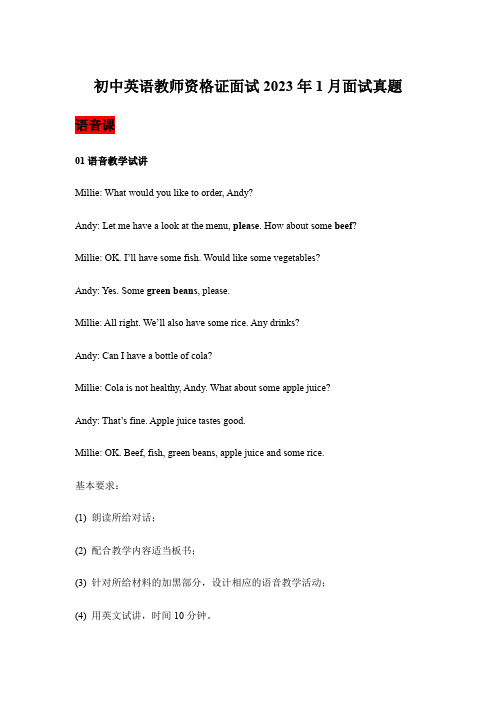
初中英语教师资格证面试2023年1月面试真题语音课01语音教学试讲Millie: What would you like to order, Andy?Andy: Let me have a look at the menu, please. How about some beef?Millie: OK. I’ll have some fish. Would like some vegetables?Andy: Yes. Some green beans, please.Millie: All right. We’ll also have some rice. Any drinks?Andy: Can I have a bottle of cola?Millie: Cola is not healthy, Andy. What about some apple juice?Andy: That’s fine. Apple juice tastes good.Millie: OK. Beef, fish, green beans, apple juice and some rice.基本要求:(1) 朗读所给对话;(2) 配合教学内容适当板书;(3) 针对所给材料的加黑部分,设计相应的语音教学活动;(4) 用英文试讲,时间10分钟。
02语音教学试讲Kitty: What do you think about my red gloves, Amy?Amy: Oh, they’re nice. What are they made of?Kitty: They’re made of leather.Amy: They feel soft and smooth.Kitty: Yes, and red is my favourite colour.Amy: You look lovely in your new hat. What’s it made of? Kitty: It’s made of wool. I like it too.基本要求:(1) 朗读所给对话;(2) 配合教学内容适当板书;(3) 针对所给材料的加黑部分,设计相应的语音教学活动;(4) 用英文试讲,时间10分钟。
教师资格考试初级中学英语面试试题与参考答案
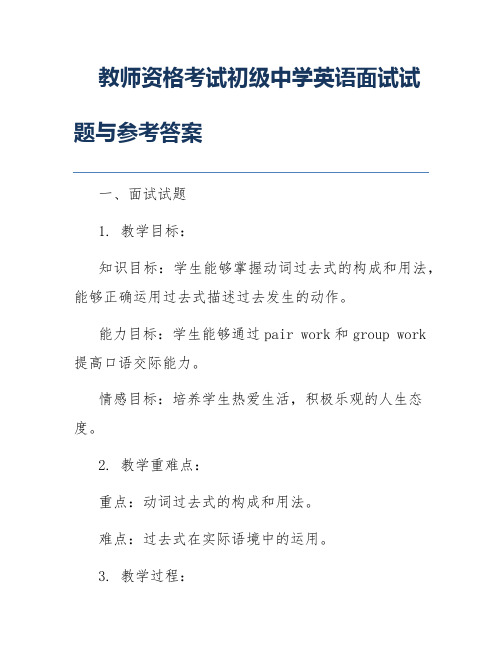
教师资格考试初级中学英语面试试题与参考答案一、面试试题1. 教学目标:知识目标:学生能够掌握动词过去式的构成和用法,能够正确运用过去式描述过去发生的动作。
能力目标:学生能够通过pair work和group work 提高口语交际能力。
情感目标:培养学生热爱生活,积极乐观的人生态度。
2. 教学重难点:重点:动词过去式的构成和用法。
难点:过去式在实际语境中的运用。
3. 教学过程:Step 1:热身(5分钟)老师与学生进行简单的英语对话,询问学生昨天做了什么,引导学生回顾过去式的概念。
Step 2:新课导入(10分钟)老师通过图片展示不同的动词过去式例子,引导学生发现动词过去式的构成规律。
学生分组讨论并总结规律。
Step 3:课堂练习(10分钟)学生分成小组,根据老师提供的场景,用动词过去式编写对话。
老师选取几组对话进行展示和点评。
Step 4:拓展活动(10分钟)学生分成小组,根据老师提供的图片,用动词过去式编写小故事。
老师选取几组故事进行展示和点评。
Step 5:总结与作业布置(5分钟)老师对本节课的内容进行总结,强调动词过去式的用法。
布置作业:用动词过去式写一篇关于昨天经历的短文。
二、参考答案1. 教学目标:知识目标:学生能够掌握动词过去式的构成和用法,能够正确运用过去式描述过去发生的动作。
能力目标:学生能够通过pair work和group work 提高口语交际能力。
情感目标:培养学生热爱生活,积极乐观的人生态度。
2. 教学重难点:重点:动词过去式的构成和用法。
难点:过去式在实际语境中的运用。
3. 教学过程:Step 1:热身(5分钟)老师与学生进行简单的英语对话,询问学生昨天做了什么,引导学生回顾过去式的概念。
例:Teacher: Hi, girls and boys. How was your yesterday?Student: Hi, teacher. Yesterday I played basketball with my friends.Step 2:新课导入(10分钟)老师通过图片展示不同的动词过去式例子,引导学生发现动词过去式的构成规律。
初中英语教师资格证面试真题.doc

1 题目:词汇教学2 内容:Well, I hope you’re enjoying my school in New York. I like your school in Beijing, but I’m not feeling very well at the moment. I’m tired and have a lot of headaches. And I’m stressed out because my putonghua isn't improving. I study late every night, sometimes until 2 am., but I don't think I’m improving. I really need some conversation practice!I think I have a cold, too.3 基本要求:(1)朗读所给段落(2)配合教学内容适当板书(3)举例解释段落中三个黑体词汇的意义,并设计相应的词汇运用教学活动。
(4)试讲时间:约10分钟。
(5)用英文试讲1 题目:听力教学试讲2内容:When I grow up, I’m going to do what I what to do. I’m going to move somewhere interesting. Paris sounds like a city that I could enjoy. There are lots of art exhibitions there. I want to be an artist. So how am I going to do it? First, I’m going to find a part-time job for a year or two and save some money. Then I’m going to be a student at an art school in Paris. And I ’m going to study French at the same time. Next I’ m going to hold art exhibitions because I want to travel all over the world .One day, I’ m going to retire somewhere quiet and beautiful.3 基本要求:(1)朗读所给段落(2)配合教学内容适当板书(3)设计听力教学活动(4)试讲时间:约10分钟。
2022下半年初中英语教师资格证面试真题及答案(一)
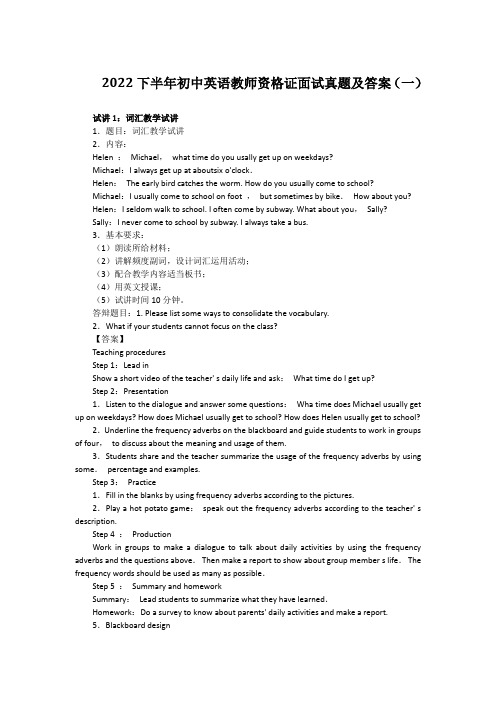
2022下半年初中英语教师资格证面试真题及答案(一)试讲1:词汇教学试讲1.题目:词汇教学试讲2.内容:Helen :Michael,what time do you usally get up on weekdays?Michael:I always get up at aboutsix o'clock.Helen:The early bird catches the worm. How do you usually come to school?Michael:I usually come to school on foot ,but sometimes by bike.How about you?Helen:I seldom walk to school. I often come by subway. What about you,Sally?Sally:I never come to school by subway. I always take a bus.3.基本要求:(1)朗读所给材料;(2)讲解频度副词,设计词汇运用活动;(3)配合教学内容适当板书;(4)用英文授课;(5)试讲时间10分钟。
答辩题目:1. Please list some ways to consolidate the vocabulary.2.What if your students cannot focus on the class?【答案】Teaching proceduresStep 1:Lead inShow a short video of the teacher' s daily life and ask:What time do I get up?Step 2:Presentation1.Listen to the dialogue and answer some questions:Wha time does Michael usually get up on weekdays? How does Michael usually get to school? How does Helen usually get to school?2.Underline the frequency adverbs on the blackboard and guide students to work in groups of four,to discuss about the meaning and usage of them.3.Students share and the teacher summarize the usage of the frequency adverbs by using some.percentage and examples.Step 3:Practice1.Fill in the blanks by using frequency adverbs according to the pictures.2.Play a hot potato game:speak out the frequency adverbs according to the teacher' s description.Step 4 :ProductionWork in groups to make a dialogue to talk about daily activities by using the frequency adverbs and the questions above.Then make a report to show about group member s life.The frequency words should be used as many as possible.Step 5 :Summary and homeworkSummary:Lead students to summarize what they have learned.Homework:Do a survey to know about parents' daily activities and make a report.5.Blackboard design试讲2:写作教学试讲1.题目:写作教学试讲2.内容:Subject:The cookie sale.Time:lunch time after school.Place:in the hall.Price:0.25 dollars.Purpose :Raise money to donate.Notice:The first letter should be capitalized.3.基本要求:(1)朗读所给内容;(2)配合教学内容适当板书;(3)根据所给材料的内容,设计海报写作的教学活动;(4)用英文试讲;(5)试讲时间:10分钟。
初中英语教师资格证面试试讲题库
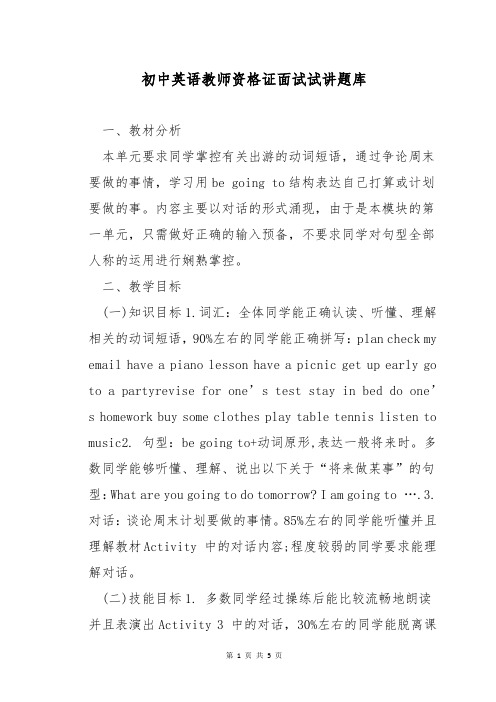
初中英语教师资格证面试试讲题库一、教材分析本单元要求同学掌控有关出游的动词短语,通过争论周末要做的事情,学习用be going to结构表达自己打算或计划要做的事。
内容主要以对话的形式涌现,由于是本模块的第一单元,只需做好正确的输入预备,不要求同学对句型全部人称的运用进行娴熟掌控。
二、教学目标(一)知识目标1.词汇:全体同学能正确认读、听懂、理解相关的动词短语,90%左右的同学能正确拼写:plan check my email have a piano lesson have a picnic get up early go to a partyrevise for one’s test stay in bed do one’s homework buy some clothes play table tennis listen to music2. 句型:be going to+动词原形,表达一般将来时。
多数同学能够听懂、理解、说出以下关于“将来做某事”的句型:What are you going to do tomorrow? I am going to ….3.对话:谈论周末计划要做的事情。
85%左右的同学能听懂并且理解教材Activity 中的对话内容;程度较弱的同学要求能理解对话。
(二)技能目标1. 多数同学经过操练后能比较流畅地朗读并且表演出Activity 3 中的对话,30%左右的同学能脱离课本表演出对话。
2. 全体同学能依据老师提供的分层情境,两人或多人小组编出一段关于“计划”的对话,并在全班做展示沟通。
(三)情感目标1. 通过相互问答练习,熬炼同学有目的、有计划地做事,养成统筹安排的好习惯。
2. 通过询问他人周末计划状况,加强同学之间的`沟通与合作,形成互帮互助的良好学习氛围。
三、教学重点难点1.重点:学习be going to结构描述将来要做的事。
知识目标中词汇与句型的讲授与学习。
教师资格证初中英语面试真题集
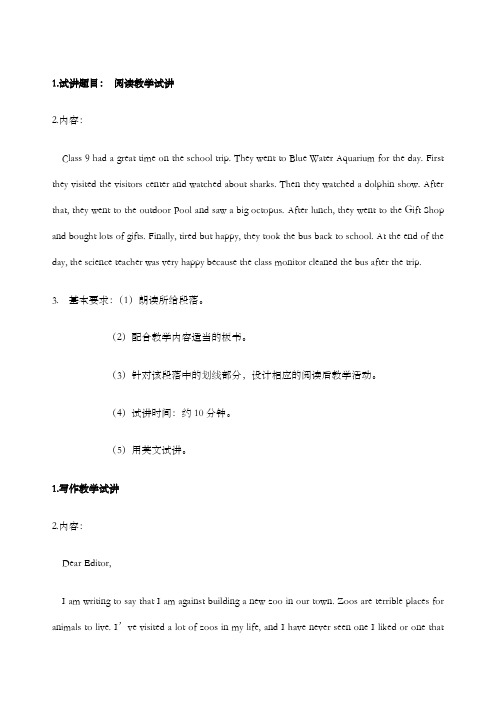
1.试讲题目:阅读教学试讲2.内容:Class 9 had a great time on the school trip. They went to Blue Water Aquarium for the day. First they visited the visitors center and watched about sharks. Then they watched a dolphin show. After that, they went to the outdoor Pool and saw a big octopus. After lunch, they went to the Gift Shop and bought lots of gifts. Finally, tired but happy, they took the bus back to school. At the end of the day, the science teacher was very happy because the class monitor cleaned the bus after the trip.3. 基本要求:(1)朗读所给段落。
(2)配合教学内容适当的板书。
(3)针对该段落中的划线部分,设计相应的阅读后教学活动。
(4)试讲时间:约10分钟。
(5)用英文试讲。
1.写作教学试讲2.内容:Dear Editor,I am writing to say that I am against building a new zoo in our town. Zoos are terrible places for animals to live. I’ve visited a lot of zoos in my life, and I have never seen one I liked or one thatwas suitable for animals to live in. Just last week, I visited a zoo and couldn’t believe what I saw. The animals are kept in tiny cages and can hardly move at all. And they are only given food once a day. Is this a good way for animals to live? I don’t think so.Sincerely,Disgusted 3 基本要求:(1)朗读所给短信。
2024年5月初中英语教师资格证面试真题

2024年5月初中英语教师资格证面试真题语法课01语法教学试讲Dear Isabel,Thank you for your last letter.Here are photos of me and my twin sister Liu Ying.As you can see,in some ways,we look the same and in some ways,we look different.We both have black eyes and black hair, although my hair is shorter than hers.We both like sports,although Liu Ying is more athletic than me.She's more outgoing and I'm quieter.I think,I'm smarter than her.My favorite subjects are physics and chemistry,and her favorite subject is PE.However,we both enjoying going to the parties.Please visit us soon!基本要求:(1)朗读所给材料。
(2)配合教学内容适当板书。
(3)针对材料所给划线部分,设计相应的语法教学活动。
(4)用英文试讲。
(5)试讲时间:10分钟。
02语法教学试讲This afternoon,we went to Ocean Park.It isn't far from the restaurant where we ate lunch.Unfortunately,we got lost.Our taxi driver didn't know understand what we were saying.Luckily,a man who understood Putonghua told the driver where we were going.Ocean Park has a lot of marine,or ocean animals as well as some very exciting rides.Dad and I went on a ride that goes round and round very fast,Afterwards,Mum wanted to go to a market but I was too tired.Dad and I went back to the hotel and Mum went to the market by herself.基本要求:(1)朗读所给材料。
初中英语教师资格证面试真题
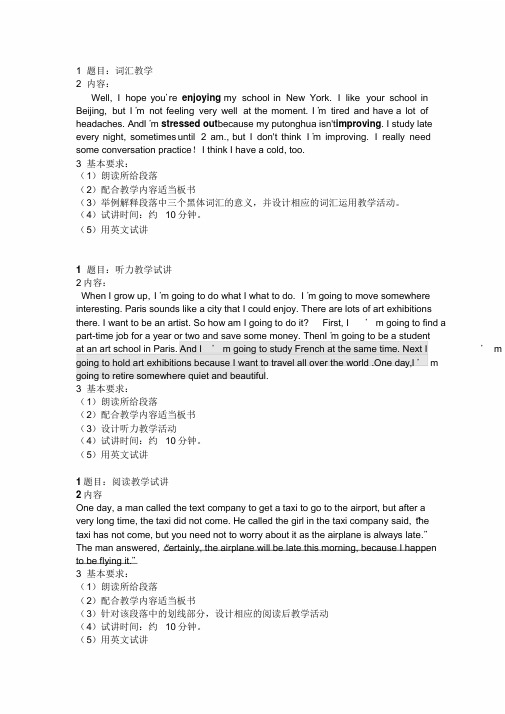
1 题目:词汇教学2 内容:Well, I hope you’re enjoying my school in New York. I like your school inBeijing, but I ’m not feeling very well at the moment. I ’m tired and have a lot ofheadaches. AndI ’m stressed out because my putonghua isn't improving. I study lateevery night, sometimes until 2 am., but I don't think I ’m improving. I really needsome conversation practice!I think I have a cold, too.3 基本要求:(1)朗读所给段落(2)配合教学内容适当板书(3)举例解释段落中三个黑体词汇的意义,并设计相应的词汇运用教学活动。
(4)试讲时间:约10 分钟。
(5)用英文试讲1 题目:听力教学试讲2 内容:When I grow up, I ’m going to do what I what to do. I ’m going to move somewhereinteresting. Paris sounds like a city that I could enjoy. There are lots of art exhibitionsthere. I want to be an artist. So how am I going to do it? First, I ’m going to find apart-time job for a year or two and save some money. ThenI ’m going to be a studentat an art school in Paris. And I ’m going to study French at the same time. Next I ’m going to hold art exhibitions because I want to travel all over the world .One day,I ’mgoing to retire somewhere quiet and beautiful.3 基本要求:(1)朗读所给段落(2)配合教学内容适当板书(3)设计听力教学活动(4)试讲时间:约10 分钟。
初中英语教师资格证面试2023年12月面试真题

初中英语教师资格证面试2023年12月面试真题阅读课01阅读教学试讲Dear friend,I know you are arriving next Sunday.Let me tell you the way to my house.Take a taxi from the airport.You pass a bank on your right and then go down Long Street.You go through Sixth Avenue,Seventh Avenue,and Eighth Avenue.When you see a big supermarket,turn left.Then go down Bridge Street and turn left at New Park.Go down Center Street and my house is on your right.基本要求:(1)朗读所给材料。
(2)配合教学内容适当板书。
(3)针对材料所给内容,设计相关阅读教学活动。
(4)用英文试讲。
(5)试讲时间:10分钟。
02阅读教学试讲The Encyclopaedia Britannica is a world-famous encyclopedia.It is the oldest English-language encyclopedia.The first edition was published in1768,and since then there have been15editions.The15thedition is made up Enoclopodia Britannicaof32volumes.Together they contain about40million words on half a million topics. The15th edition was the last printed edition,Today you can find the Britannica online.基本要求:(1)朗读所给材料。
初中英语面试试讲真题

教师招聘面试中学英语真题和答案教师资格证中学英语面试阅读题真题一1.试讲题目:阅读教学试讲2.内容:One day, a man called the taxi company to get a taxi to go to the airport, but after a very long time, the taxi did not come. He called the girl in the taxi company again. The girl in the taxi company said, “the taxi has not come, but you need not to worry about it as the airplane is always late.” the man answered, “certainly, the airplane will be late this morning, because I happen to be flying it.”3.基本要求:(1)朗读所给段落。
(2)配合教学内容适当的板书。
(3)针对该段落中的划线部分,设计相应的阅读后教学活动。
(4)试讲时间:约10分钟。
(5)用英文试讲。
题目的是用机器抽好然后打印在一张纸上面的,以前在网上看到说会给你2个题目选择,但是实际情况是只是给你一道指定的题目。
这种做法在一定程度是有点不公平,因为用全英文来教授语法显然比全英文教授口语或者阅读要难的多,因为语法中那一大推的专业名词用中文你都不一定能够说的出来,更别说英文了。
但是不管是网上传言还是从我的实际参考来看,抽到的类似上面我所抽到的阅读题型的学生是最多的。
因此大家要重视这种题型的作答方法。
OK,在提前二十分钟抽到题后,我和其他的同学一起在一个教室里面写教案。
我旁边的一个华师的女生抽到的是听力题。
当然了,这是她自己说的,写教案的时候是不许交谈,不许带参考资料,也不许打开手机,违者属于作弊,这个监考人员一再强调过的,所以只能靠自己平时积累的一些东西来完成接下来的整个面试了。
